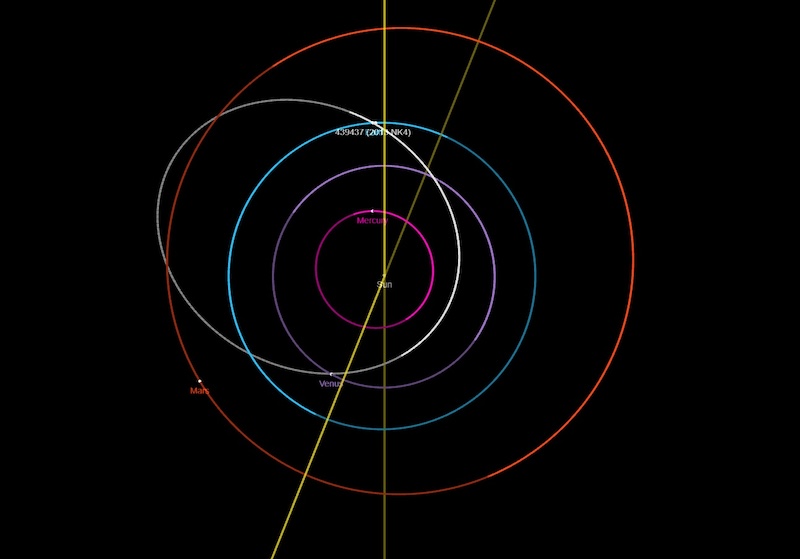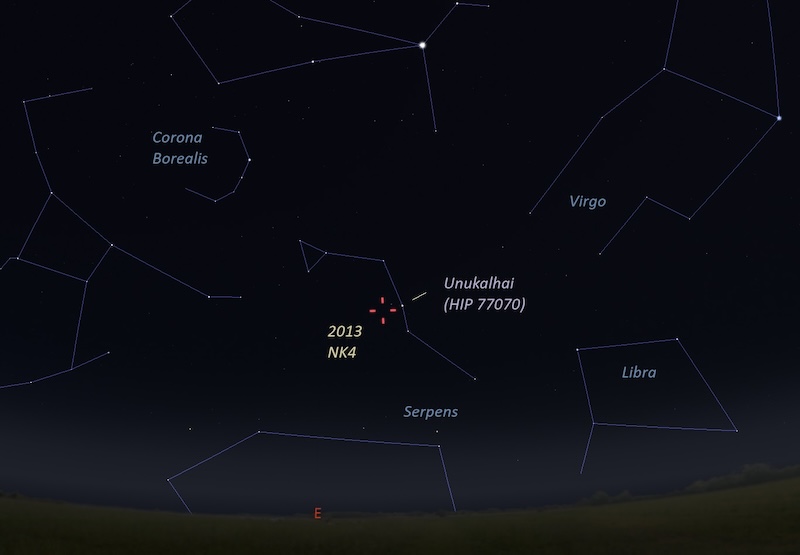Update! Image of asteroid 2013 NK4
NASA astronomers were able to obtain radar images of the large asteroid that passed Earth safely on Monday, April 15, 2024. They captured an image of the asteroid – named 2013 NK4 – using the Goldstone Radar in California on April 13. NASA said:
Radar narrow echoes probably establish that 2013 NK4 rotates very slowly, and the shape is bifurcated.
These observations suggest asteroid 2013 NK4 is probably a binary contact. That means it’s composed of two bodies or asteroids that have gravitated toward each other until they touch, resulting in this elongated shape. If a two-lobed asteroid sounds familiar to you, that’s because we’ve seen space rocks like this before. For example, there’s 4769 Castalia, discovered in 1989. It’s even larger at 1.4 kilometers (0.87 miles) in diameter and is also classified as a potentially hazardous asteroid. And another example is Arrokoth, visited by the New Horizons mission. Arrokoth looks a bit like a snowman and lies out in the Kuiper Belt.
Large asteroid is bigger than Apophis
Asteroid 2013 NK4 has a diameter of about 2,000 feet (610 meters). That makes it about twice as large as Apophis, the so-called doomsday asteroid that will pass closer than Earth’s artificial satellites in 2029. But 2013 NK4 passed us at a much greater distance. It was more than eight times the moon’s distance at its nearest to us. What’s so amazing about it? People with telescopes will be able to watch it fly by Earth!
Closest approach for asteroid 2013 NK4 happened on Monday, April 15, 2024, at 14:51 UTC. But, due to its location in the sky, it’ll be easier to see through a telescope on the nights of April 16 and 17. See finder charts below.
Attention astronomy enthusiasts! Are you looking for a way to show your support for astronomy education? Donate to EarthSky.org here and help us bring knowledge of the night sky and our universe to people worldwide.

The asteroid’s orbit
Because the asteroid occasionally passes near Earth and is a fairly large space rock, 2013 NK4 holds the scary-sounding designation of Potentially Hazardous Asteroid. However, we’ve known about asteroid 2013 NK4 since 2013 (thus the year designation in its name), and it has a well-defined orbit. There was absolutely no danger to Earth during its flyby.
2013 NK4 orbits the sun every 378 days. But its orbit is slightly more elliptical than ours. Its orbit goes out past Mars and then dives in between the orbits of Venus and Mercury. The asteroid sped past our planet at 36,909 miles per hour (59,400 km per hour) or 10.2 miles per second (16.5 km per second) relative to Earth.
Use a telescope to see the large asteroid
Using GoTo or computerized telescopes makes observing an asteroid easier than ever before. You’ll be able to see the asteroid in the telescope eyepiece or screen as a slowly moving point of light in front of the background stars.




NASA will be studying NK4
According to NASA/JPL, astronomers will be imaging the space rock using the 230-foot (70-meter) DSS-14 Goldstone radar antenna in California from April 13-19. (See image above from April 13.) Also, on April 14, observations of this object were scheduled from Canberra, Australia, using NASA’s 34-meter (112-foot) DSS-35 dish antenna.
Scientists expect to acquire highly detailed delay-Doppler images, which should show the asteroid’s shape and perhaps allow them to better refine the space rock’s size.
Large asteroid passed Earth! EarthSky’s Deborah Byrd created this 1-minute video summary for you.
Bottom line: A large asteroid – 2013 NK4, which spans about 2,000 feet (610 meters) across – safely passed Earth on April 15, 2024. It’ll be visible in small telescopes on April 16 and 17. And check out the image from the Goldstone Radar in California from April 13. It shows a two-lobed object.